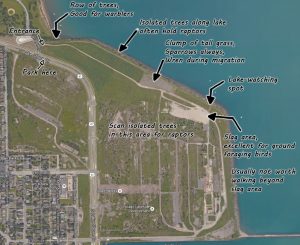Park No. 566
eBird Hotspot: http://ebird.org/ebird/hotspot/L3934103
About-
Part of the historic US Steel South Works plant, the land occupied by the present-day park, was cleared in the late 1990’s. The land was acquired in 2004 by McCaffery Interests and, in an agreement with the city, subsequently deeded part of the land as a park. The Chicago Park District currently has a framework plan in place that will greatly alter the current state of the abandoned land but, no timeline has been set. The plan can be found on the CPD website.
Getting there-
Park No. 566 is most easily accessed from Lake Shore Drive, near the entrance to Rainbow Beach Park. You will pull past the intersection of S Farragut Dr & S Lake Shore Dr (for those coming from the north) and parallel park along the side of the road. Coming from the south, you will make a U-turn at that intersection to park on the south side of S Lake Shore Dr, east of Farragut. For those wishing to travel to the park in a low-carbon fashion, there are a variety of bus routes that travel nearby as well as the Cheltenham (79th St.) Metra Electric stop less than a half-mile away. The entrance into the park is off of Farragut. Look for a yellow gate. The path begins there.
How to bird-
The private land adjacent to the park runs along the south edge of the gravel path. As such, you won’t venture much off this path while birding this area. Hiking is an in-and-out endeavor. You’ll simply walk as far as you’d like and turn around. Lake-watchers will walk in until you find a mulch path headed north, there is a berm running along the slag shoreline which creates a good place to set up a scope. Unless you’re planning on lake-watching, avoid days with strong winds as it will keep the birds down in the grass and difficult to find. After rain, the path will likely be very muddy. No bathroom facilities are within walking distance.
Birds found there-
Walking along the path, sparrows and other grassland birds are definitely the prime attraction with individual counts often above 100. In addition to the typical Emberizids, Grasshopper, Clay-colored, Henslow’s, Le Conte’s, and Nelson’s Sparrows have all been found here. Raptors are also common visitors. Northern Harriers and Short-eared Owls can occasionally be found sitting on the side of the path; more so the farther you walk in. The row of trees near the entrance to the park can hold a surprising array of spring and fall warblers and, because of the relatively large tract of land and its position of jutting out into the lake, the numbers of migrants can occasionally be outstanding. During the summer, Killdeer and Spotted Sandpipers are often seen running along the edges of the path. Other shorebirds may occasionally be found but the habitat is suitable only as a temporary stopping place and are definitely not typical. Gulls and waterfowl are regularly seen as at many other lakefront sites. However, when at the “lake-watching spot” be mindful that the Indiana border is a few hundred feet offshore due east. You’re best bet for Illinois viewing is focusing northward, back at the downtown area. Late fall/early winter is an excellent time to walk to the clearing (Slag area) and look for ground foraging birds. Horned Lark, Snow Bunting, and Lapland Longspur can assemble in huge flocks as they scrounge for seed in the open area. Winter residents are limited to White-crowned and American Tree Sparrows along with a few other common sparrow species.
Why this place is special-
There are many great places to bird in Chicago. Even the best feel very urban and surrounded by human activity. When you visit Park No.566, you’ll probably be the only person there. With S Lake Shore Dr not being heavily traveled, there are moments when you forget you’re standing within the boundaries of a large city.
